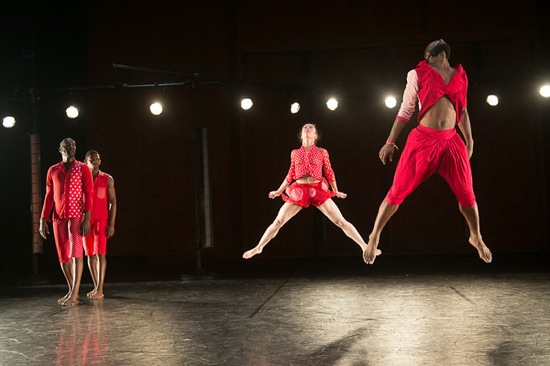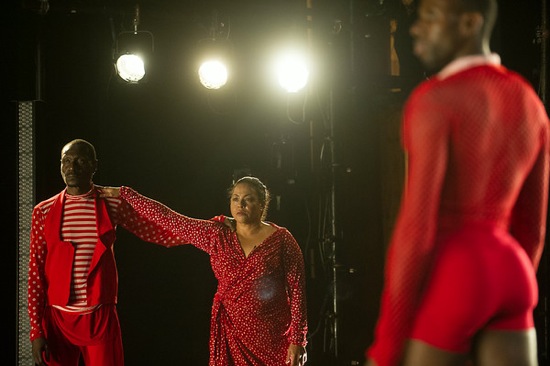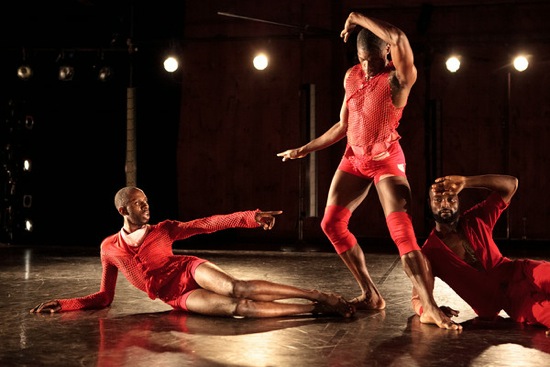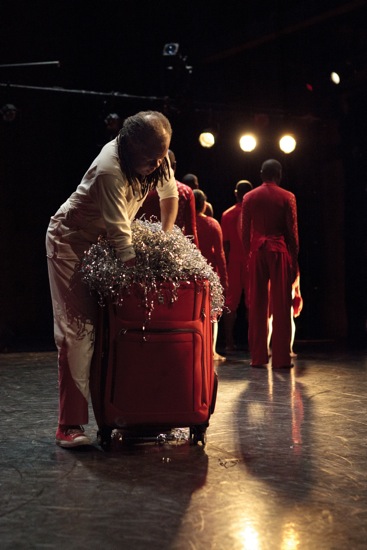Reggie Wilson/Fist and Heels Performance Group presents Moses(es) at Jacob’s Pillow.

Reggie Wilson’s Moses(es), (L to R): Dwayne Brown, Yeman Brown, Anna Schön, Clement Menshah. Photo: Christopher Duggan
The first event you see in Reggie Wilson/Fist and Heel Performance Group’s Moses(es) at Jacob’s Pillow is Reggie Wilson getting up the nerve to say something. He stands in the Doris Duke Studio Theater and looks the audience over—checking out the spectators, smiling nervously, waiting for. . .what? He pulls a piece of cloth from his pocket and wipes his face. I remember suddenly a line from the Bible about Moses: he was “slow of speech and tongue” and had to get Aaron to speak the message that God had ordered him to give to the Pharaoh.
Wilson is not following any of the narratives about Moses; instead he twists and turns allusions that we may not need to “get” into the fabric of dancing—embedding and layering and updating them. His travels to research religious roots, diasporas, and the enforced journeys of slaves from Africa have yielded a rich vision of Exodus. He was also influenced by Zora Neale Hurston’s 1939 Moses, Man of the Mountain, a retelling of the Bible story as an African American folk tale.
When Wilson finally gets up the nerve to speak, he introduces the eight vibrant performers, one by one. They were born in Trinidad and Tobago, Jamaica, Sierra Leone, Ghana, and the U.S. Only two are women. Then he performs what amounts to a prologue. He divides a big pile of tinsel that sits in the center of the stage by shoving it to one side and the other. So, a path through the Red Sea. The eight walk along it and cluster in a far corner staring offstage, while Wilson labors to pack all the silvery stuff into a large red wheelie. The job takes time. There’s almost too much about Moses to pack easily into a performance (that’s something you can think). You can also think about all the references to water in the tales of Moses that crop up in several Old Testament books.
Then the dancing starts. The performers make it look individual, felt. Yet though the movement is purposefully ragged-edged (not a pointed toe in sight), Wilson has groomed it into patterns that bespeak community. The flavor comes out of Africa. The earth is acknowledged in the dancers’ wide-legged, bent-kneed stances; their straight-up jumps, their flashing-out kicks; their whirlings to face new directions; and more. For instance, they make gathering-in gestures, roll along the floor like the River of Jordan, and lie on their backs waving their arms and legs in the air. We see how interesting the movement vocabulary can get when individuals have a chance to display their own variations on it. Emerging one by one from a group at the back, they might even have been improvising a bit, judging by the approving smiles of their colleagues.
The ambiance owes much to Jonathan Belcher’s lighting. The dimness, the explosions of brightness, the blood-red saturation, the panoply of dots on ceiling and walls mark the travels and the troubles of these people, these Moseses—each in his or her own way, a leader. Naoko Nagata’s extraordinary red costumes make the performers look both dapper and as if they’d had to patch together remnants of this and that.

Reggie Wilson’s Moses(es). Foreground: Raja Feather Kelly; at back: Laurence A.W. Harding and Rhetta Aleong. Photo: Christopher Duggan
The excellently chosen musical selections begin with Louis Armstrong singing “Go Down Moses” and end with the Southern Sons’ arrangement of the same song and The Blind Boys of Alabama delivering “Wade in the Water.” In between these, the styles and artists vary: the house music of Aly Us, songs by the Ngqoko Women’s Ensemble from South Africa, Egyptian zar by Mazaher, calypso by The Growling Tiger, klezmer music by The Klezmatics, and more. Sometimes the dancers sing along, and, as I remember, it’s only their voices that call out “Eli, Eli (Somebody Call Eli).” At times Rhetta Aleong and Laurence A.W. Harding drop out of the dancing to sing.
Some of the accompaniment was composed by Wilson, and he often sits on a chair at the back—stamping, clapping, and slapping out rhythms. Interestingly, when his rhythms accompany recorded music, the dancers may follow them, creating intriguing textural cross-currents. (It’s worth noting that slaves in the American South were forbidden to play musical instruments and relied on the rhythms they could create with their bodies.)
Wilson and the performers are skillful at making movements performed in canon look like a follow-the-leader game and unison dancing appear as consensus. There are also some striking choreographic passages that suggest that they could be partially improvised (that might not be true, since a miscalculation could endanger the participants). In one crazily beautiful passage, all eight (as I recall) keep dropping into and out of caterpillar formations, with each person grabbing the waist of the person in front and all of them jolting along in a line, almost squatting. This keeps happening during a boil-up of vigorous dancing. You can’t predict when and where a three-person caterpillar will materialize, or how a person will drop into one without apparent premeditation; a split second earlier, he or she was dancing hell for leather.
In another, more controlled episode, the six men spell each other in trios. One guy vaults toward another, but is passed over him and caught by the third. I’m impressed, too, by the casualness of their games of strength. Small Anna Schön can hold a man on her back for several seconds, as he rolls onto her and off to engage in more dancing. No big deal, although she’s the only woman holding her own amid a bunch of men.
One of Wilson’s stated influences is fractal symmetry, in which identical patterns, growing ever smaller in scale, repeat inside each other (“double c, double b, double a,” chants Aleong over and over as part of a sequence). He also offers a clue to this phenomenon in a moment when the hard-travelling dancers rest, Aleong’s hair has come down; Schön expertly but carefully re-plaits it, and you think of the braids-within-braids of the most elaborate African hairdos.
Only near the very end, when the dancers are reprising some of their earlier passages, do I wish for something new, something that suggests a change. But maybe that’s not a part of what Wilson means to say. Maybe what matters to him is that some journeys never end, or only instigate new ones. It took the Israelites an eternity to reach the Promised Land. The slaves from Africa journeyed to the Americas under duress; then, during the Civil War, some escaped and made their way north on the Underground Railroad. Pilgrimages become rituals. It also matters to Wilson that followers become leaders and vice versa, and his choreography shows that equality.

Reggie Wilson’s Moses(es). (L to R): Raja Feather Kelly, Dwayne Brown, and Clement Mensah. Photo: Jamie Kraus
These smart, hardy dancing avatars of Moses vary in size from tall, skinny Dwayne Brown to diminutive Schön. Their diversity is as enjoyable as their disciplined consensus. The heroes not mentioned so far are Yeman Brown, Paul Hamilton, Raja Feather Kelly, and Clement Mensah.


